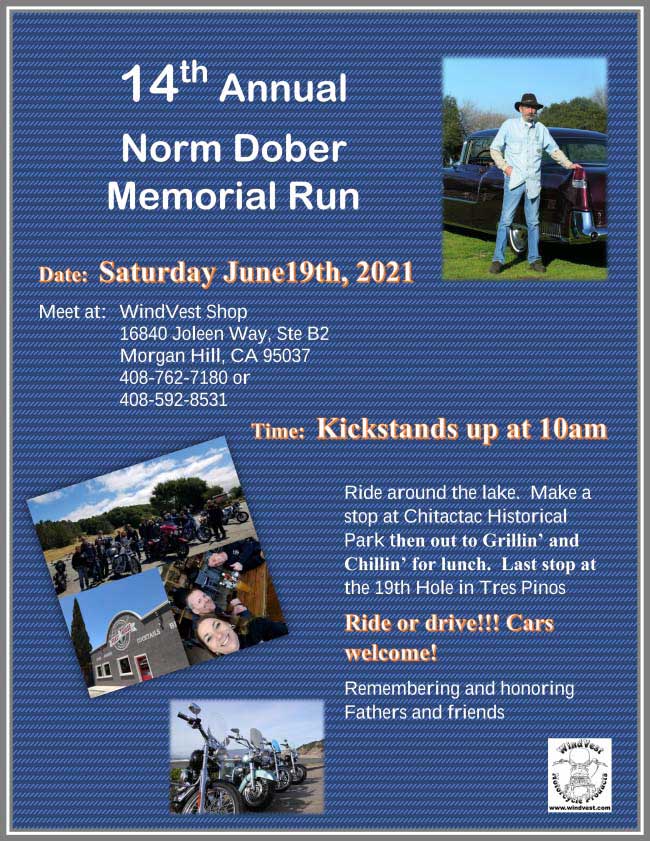Peter Fonda’s motorcycle from ‘Easy Rider’ is heading to auction
By Wayfarer |
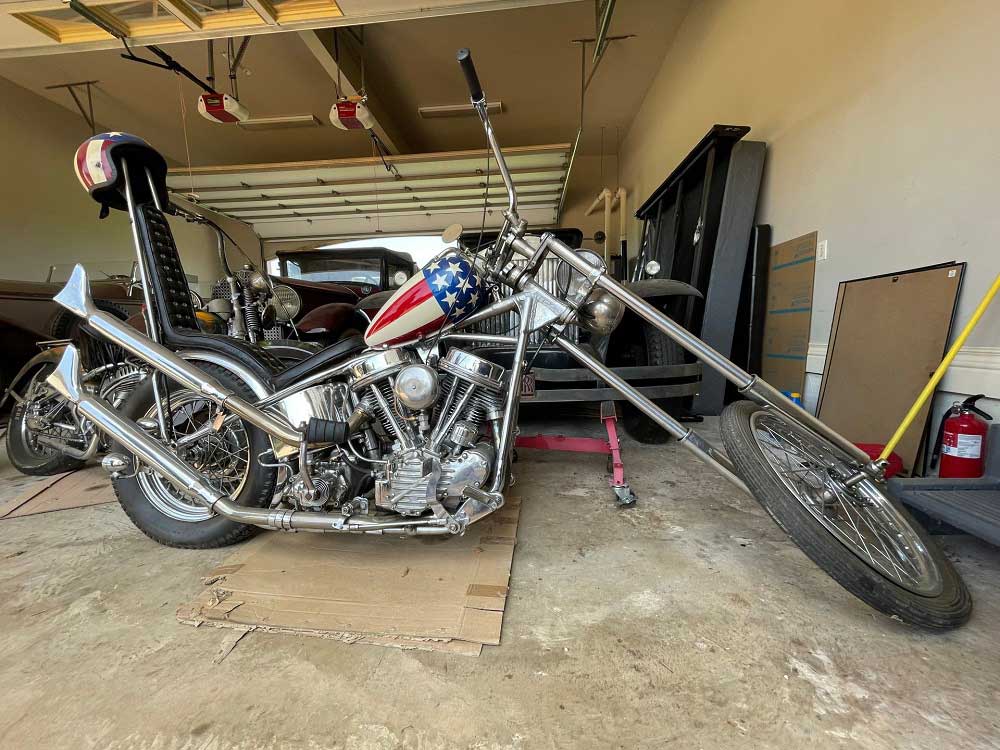 from https://www.malaymail.com
‘Captain America,’ the motorcycle that had a starring role in ‘Easy Rider’ should easily find a buyer at an auction held in Texas on June 5, 2021. ― Picture courtesy of Cord & Kruse Auctions via ETX Studio.
LOS ANGELES, May 15 ― The iconic “Captain America”, the motorcycle that Peter Fonda rode in the movie Easy Rider, will be auctioned off in Texas on June 5, 2021. Famous for the star-spangled banner painted on its gas tank, the motorcycle is currently estimated at between US$ 300,000 and US$ 500,000.
The motorcycle in question, symbol of freedom and the hippie movement of the era, will be sold without a reserve price. This exceptional model, famous across the world, was built from an old 1952 Harley-Davidson bike bought for a pittance at the time. In 1996, the bike’s owner at the time, collector Gary Graham, sold the Captain America bike at the Dan Kruse Classic Car Productions auction to Gordon Granger. Since then, the bike has resided in Austin, Texas, where it even survived a fire in December 2010.
For anyone who needs a reminder, the film Easy Rider was directed by Dennis Hopper and released in 1969. The movie is a cult road movie about two bikers leaving California to reach Louisiana. The authenticity of this model for sale is nevertheless debated among some aficionados. For the record, two bikes were used for the shoot. In 2014, one of them was sold for 1.3 million dollars.
In addition to Captain America, about 20 other vehicles from Gordon Granger’s collection will also be offered at auction on June 5, all without reserve prices. This selection includes, for example, several Rolls-Royces from the 1920s and 1930s, a 1954 Jaguar XK120 Roadster and a 1964 Ford Mustang convertible. Also noteworthy in this sale is a replica of the famous “General Lee” Dodge from the series The Dukes of Hazzard. ― ETX Studio
from https://www.malaymail.com
‘Captain America,’ the motorcycle that had a starring role in ‘Easy Rider’ should easily find a buyer at an auction held in Texas on June 5, 2021. ― Picture courtesy of Cord & Kruse Auctions via ETX Studio.
LOS ANGELES, May 15 ― The iconic “Captain America”, the motorcycle that Peter Fonda rode in the movie Easy Rider, will be auctioned off in Texas on June 5, 2021. Famous for the star-spangled banner painted on its gas tank, the motorcycle is currently estimated at between US$ 300,000 and US$ 500,000.
The motorcycle in question, symbol of freedom and the hippie movement of the era, will be sold without a reserve price. This exceptional model, famous across the world, was built from an old 1952 Harley-Davidson bike bought for a pittance at the time. In 1996, the bike’s owner at the time, collector Gary Graham, sold the Captain America bike at the Dan Kruse Classic Car Productions auction to Gordon Granger. Since then, the bike has resided in Austin, Texas, where it even survived a fire in December 2010.
For anyone who needs a reminder, the film Easy Rider was directed by Dennis Hopper and released in 1969. The movie is a cult road movie about two bikers leaving California to reach Louisiana. The authenticity of this model for sale is nevertheless debated among some aficionados. For the record, two bikes were used for the shoot. In 2014, one of them was sold for 1.3 million dollars.
In addition to Captain America, about 20 other vehicles from Gordon Granger’s collection will also be offered at auction on June 5, all without reserve prices. This selection includes, for example, several Rolls-Royces from the 1920s and 1930s, a 1954 Jaguar XK120 Roadster and a 1964 Ford Mustang convertible. Also noteworthy in this sale is a replica of the famous “General Lee” Dodge from the series The Dukes of Hazzard. ― ETX Studio3 Hollywood-famous bikes that you can add to your motorcycle collection
By Bandit |


Henry Winkler’s 1949 Triumph Trophy TR5 500 Custom in Happy Days
This Triumph Trophy TR5 500 (frame TC11198T / engine TR59016133) is one of three that were used by “The Fonz.” Although Arthur Fonzarelli was originally scripted as a bit player, TV watchers just couldn’t get enough of the loveable greaser with a knack for catchphrases and a way with the ladies. And we can thank his jacket for giving the Triumph more screen time. No kidding.

This Triumph is one of three (including a 1952 model we wrote about earlier) that were used in filming the show. Originally owned by Hollywood stuntman and racer Bud Ekins of Great Escape fame, the ’49 was customized so Winkler could handle it easier, and the 500cc classic became synonymous with the Fonz.

Paul Newman’s 1967 Škoda CZ 250 in Sometimes a Great Notion
This Škoda was given to Newman specifically for his role as Hank Stamper in the 1971 movie Sometimes a Great Notion, a film adaption of Ken Kesey’s novel that Newman directed himself.
CZ, a branch of the Czech car company that previously manufactured weapons, began building street motorcycles in 1932. Known for its powerful two-stroke bikes, it had a run of six consecutive Grand Prix World Championships from 1964–69. But CZ couldn’t fend off the rise in popularity of Japanese motorcycles and ultimately sold itself to Cagiva, which went bankrupt four years later in 1997.

Peter Fonda’s 1968 Bultaco Pursang 250 MKII Motorcycle in Easy Rider
Peter Fonda is the third-most famous actor in his family, behind father Henry and sister Jane, but there’s no doubt that he rode one of the most famous bikes in Hollywood history. This bike, however, isn’t the iconic red, white, and blue chopper from 1969’s Easy Rider; it’s the 1968 Bultaco Pursang 250 MKII that Fonda (as “Wyatt”) rode in the movie’s first scene.
One of two used in filming, this 250 MKII (frame 48-00510 / engine 48-00510) is a powerful 250cc, air-cooled, two-stroke competition model that Heritage calls “a winner in virtually any type of high-speed-based, off-road event.” The boattail 250 MKII generated 34 horsepower and was thought to be the fastest 250 in 1968.


Historical Perspective Progressive Laconia Motorcycle Week
By Wayfarer |
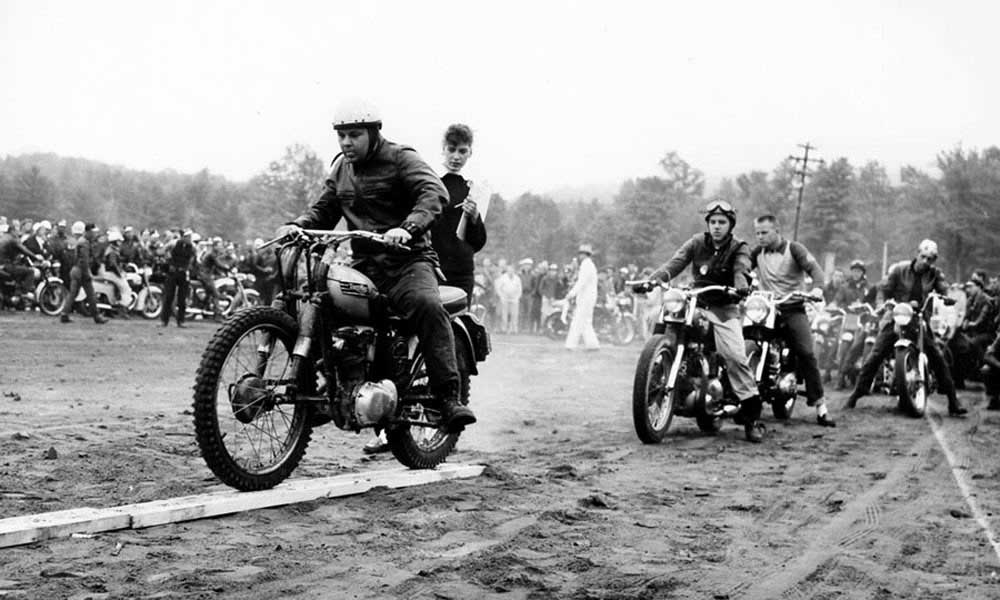
June 12th-20th, 2021 – New Hampshire – home to America’s Original Riding Rally
After a COVID-hobbled rally in 2020, Progressive Laconia Motorcycle Week® returns to New Hampshire for its 98th year, June 12 – 20. Ninety-eight years is a long time, longer than most of us have been alive, so you can imagine there are stories to tell about the world’s oldest motorcycle rally. If you’re doing the math, you’ll have to take into account the 7 years the rally wasn’t held to come up with 1916. This was the year a few hundred motorcyclists, organized by central and southern New England motorcycle dealers, traveled north for a “gypsy tour” to Weirs Beach.
Who would have known this would mark the beginnings of a tradition that would span a century? The tour was first sanctioned by the Federation of American Motorcyclists in 1917 and when the FAM disbanded in 1919, the Motorcycle and Allied Trades Association (M&ATA) took over the sanction until 1924, when the American Motorcycle Association (AMA) was formed. Back then, the weekend event centered around races and hill climbs. The number of participants grew each year as did the event’s duration. Over time, the rally blossomed into a week-long event, eventually suffering in attendance and popularity after getting wrapped up in the upheavals of the 60’s. The rally reverted to a 3-day weekend and would remain so until 1991, when organizers revived the week-long event after seeing the success of Sturgis’ 50th Anniversary Rally in 1990. Laconia Motorcycle Week reclaimed the support of local businesses and the AMA as a week-long rally and the oldest gypsy tour in the country.
Today, Laconia Motorcycle Week® is a much-expanded version of the early “gypsy tour” years, offering attendees lots of fun, food, music and, of course, countless miles of scenic riding through New Hampshire’s famed landscape. Over 230,000 riders are expected to descend on the Lakes Region this year, holding the honor of the oldest of the three national rallies with Daytona and Sturgis being Laconia’s sister rallies. Sure, all that noise and leather may seem intimidating, but don’t be fooled. Behind those leather jackets are just regular people; a multi-generational group of enthusiasts, from all walks of life, who all just happen to share in the exhilaration and liberation that riding brings.
So, be a part of Motorcycle Week history. Plan a ride to New Hampshire for this year’s Motorcycle Week (June 12 – June 20). Whether it’s your first or 98th visit, you’ll find the shared passion for riding, around which this event was founded, has never changed.
Laconia Motorcycle Week® gives great appreciation to all of our sponsors, especially our Presenting Sponsors: Progressive, AMSOIL and Team Motorcycle, as well as the State of New Hampshire for their large financial support of our rally each year.
For more information about visiting the state of NH, check out visitnh.gov.
Laconia – where rallies were invented!
Historic Off-Road Show at the Harley-Davidson Museum
By Wayfarer |
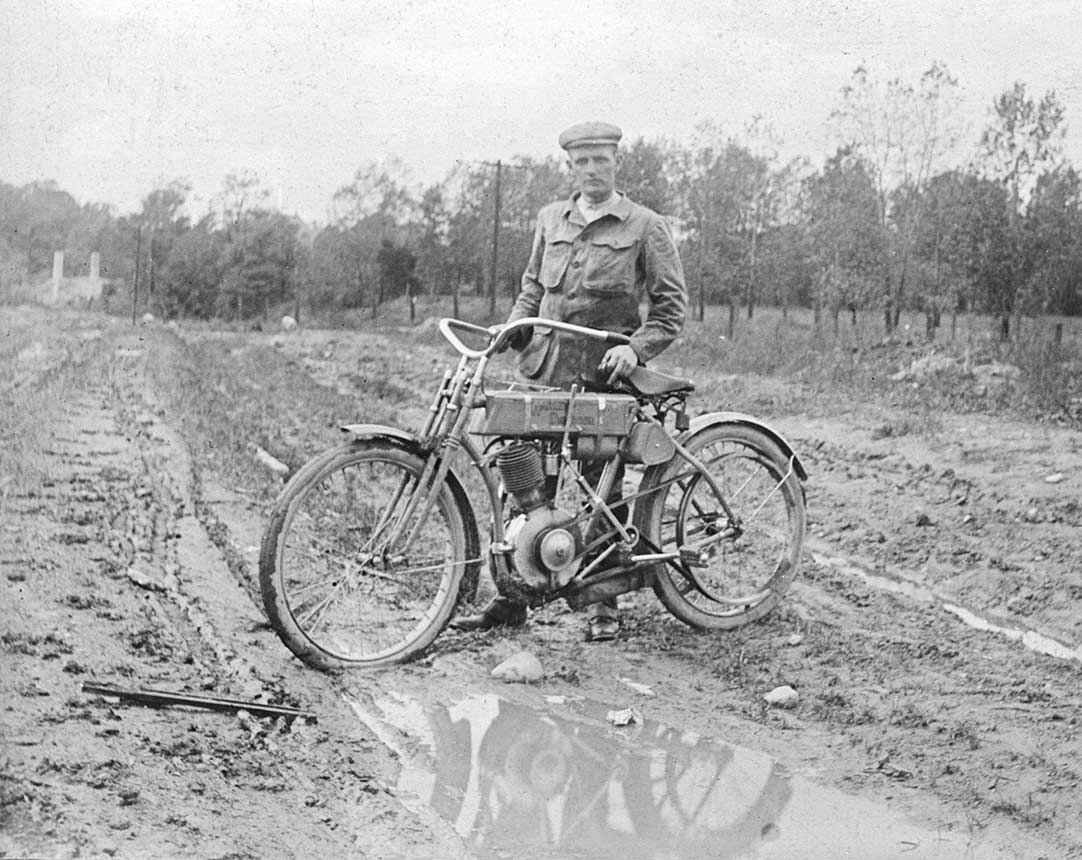
by Skyler Chun from https://www.milwaukeemag.com
Preview: A Historic Show at the Harley-Davidson Museum. Learn all about the history of off-road motorcycling at the Harley-Davidson Museum.
A new exhibit – about the storied past of off-road motorcycles and the people who rode them – has rolled into the Harley-Davidson Museum.
“There’s a deep history here with this type of riding,” exhibits curator David Kreidler says, adding that the company has long made special motorcycles designed to be ridden across difficult terrain. After all, when the company was founded in 1903, roads weren’t widely paved, and riders needed to be able to maneuver their bikes across rutted earth, or dodge fallen logs and debris.
The “Off-Road Harley-Davidson” exhibit was created to coincide with the introduction of the Pan America adventure-touring motorcycle.
One of the highlights of the exhibit, “Off-Road Harley-Davidson,” is the LiveWire, the company’s first all-electric motorcycle. The bike was featured prominently in the Apple TV+ show “Long Way Up,” which followed Ewan McGregor and his friend motorbiking from South America to Los Angeles. Older bikes are also on display.
While the museum is open to the public, it’s planning virtual events as well. To replicate the experience of walking through the galleries, Kridler will lead tours of the exhibit space that viewers can access online if they’d rather not visit in person.
“Off-Road Harley-Davidson” looks back at Harley’s history of all-terrain motorcycles. Visit the Harley-Davidson webpage for more information.
“Off-Road Harley-Davidson” exhibit celebrates the company’s past
by Mark Gardiner from https://www.revzilla.com
To celebrate the launch of its Pan America adventure bike, The Motor Company recently mounted a lovely exhibit called “Off-Road Harley-Davidson” at its museum in Milwaukee. Unfortunately, just as the exhibit was due to open to the public, a surge in COVID cases forced Milwaukee County to close museums!
I recently got a private tour of the exhibit from curator Dave Kreidler. You too can join Dave for a virtual gallery chat on Thursday (cost $6 or free for museum pass holders). The museum expects to reopen to the public next month.
The Pan America has been engineered for everything from comfortable touring to exploring gravel or dirt backroads and taking sand, mud and the occasional river crossing in stride. That might seem like a radical change for Harley-Davidson, but only if you forget that the company’s been selling motorcycles for more than a century. For the first few decades of its existence, sand, mud, and water crossings weren’t off-road challenges — they were features of American roads.
Harley-Davidson is older than 99.9 percent of U.S. paved roads
The first modern asphalt roads were paved in the mid-1800s, before cars and motorcycles. Bicycles became popular in the 1880s and bicyclists were the first group to lobby governments for improved roads. Still, by 1900 less than five percent of America’s roads were paved. There was a bit of an asphalt boom during the First World War, but it was limited to roads connecting manufacturing centers to ports. The war in Europe convinced the U.S. Army that trucks — and roads that could support them — were a strategic asset.
After the war, the Army sent 79 vehicles, 260 enlisted men and 35 officers, including a young Lt. Col. named D. Eisenhower, on a cross-country convoy to demonstrate the practicality of trucks and the need for better highways. They traveled from Washington, D.C. to San Francisco on the Lincoln Highway. Eisenhower returned dismayed by the dismal state of the country’s roads and bridges. Dozens of flimsy wooden bridges were destroyed by the Army convoy!
Little was done to improve the situation until the Works Progress Administration improved and paved about half a million miles of roads as part of the New Deal. Many farm-to-market roads were paved; one New Deal slogan was “Get the farmers out of the mud!”
Ike never lost his interest in road construction and as president he signed the bill that created the Interstate Highway System.
That’s a roundabout way of pointing out that the first 100,000 or so Harley-Davidson motorcycles were used on a mix of surfaces that riders of today would say called for an ADV bike, if not a full-on dual-sport. Back then, though, there were just “motorcycles.”
Curator Dave Kreidler shows “Off-Road Harley-Davidson” exhibit
The exhibit’s not arranged chronologically. “We organized it in five sections, based on the type of riding that the company was selling to people,” Dave said as we stood in front of a 1964 BTH model.
Sold as the Scat, the BTH was a 175 cc two-stroke that’s recognizable as a dual-sport in spite of its rigid rear end and a plunger fork with only a couple of inches of travel. It was one of the last models in a line of lightweight motorcycles based on the German DKW RT 125. (DKW’s intellectual property was essentially seized as war reparations, and versions of the RT 125 were sold as BSA Bantams in Britain, Harley-Davidson Hummers in the United States and the MMZ M-1A Moskva in Russia.)
The Scat was a road-legal trail bike sold with a high pipe, high fenders, and fairly knobby trials-pattern tires. An extra-low final-drive ratio was available as an option. It was one of many Harley-Davidsons that, over the years, were marketed as perfect vehicles for hunters and anglers.
Next up were a couple of displays devoted to touring in the 1910s and ’20s, which would be considered pretty intense adventure-touring by today’s standards.
In 1914, the Model 10-F was Harley-Davidson’s flagship. It had a two-speed gearbox and a “step starter” that allowed it to be started without putting it up on its rear stand. That was a real advantage if you were in terrain where there was no firm, level spot for the stand.
While researching this exhibit, Dave found a 1914 article in H-D’s dealer magazine describing a young naturalist named Hamilton Laing, who dropped by the Juneau Avenue factory on a ride from New York City to western Canada.
“I got kind of interested and poked around a little bit more on the internet for him,” Dave told me. “Lo and behold, he became a fairly well known naturalist, worked for the British Columbia Museum, and they had all of his papers.”
Laing’s papers included a memoir of another epic ride, from Brooklyn to Oakland in 1915. Laing “talks about the motorcycle in very poetic terms,” Dave said. “There’s this great passage where a speeding car passes him in Pennsylvania, and he goes on for a few paragraphs about how the motorcycle is a superior form of transportation, if you just want to stop and smell the roses. You know, not much has changed actually in that regard.”
The British Columbia Museum noted that although Laing kept his motorcycle for several more years, he did most of his work travel in Canada by canoe. An intrepid fellow!
Another period touring display is a 1921 WJ Sport, one of Harley-Davidson’s rare boxer twin offerings. “The popularity of this machine for cross country touring is due in part to its ability to travel even a burro trail,” bragged an advertising copywriter of the time.
“We wouldn’t call this a lightweight today,” Dave said. “But it was lighter than our Big Twin. The engine was easier to work on and it got good fuel mileage.” In 1921, those were important considerations. Touring riders had to perform most of their own maintenance and repairs; gasoline was expensive and often was only available from mechanics or automobile and motorcycle dealers.
Although you can see that the WJ doesn’t have much ground clearance, it does have a forgivingly low center of gravity, which was surely a boon when picking one’s way through difficult terrain at slow speed.
The next display we looked at was devoted to purpose-built race bikes. Enthusiasts had raced H-D’s heavy big twins in tough off-road events like Michigan’s Jack Pine Enduro forever but by the mid 1950s lighter, purpose-built off-road motorcycles dominated in the dirt.
The 1958 XLCH Sportster was a true production racer, sold without lights. “In some ways you could say that this was our first real off-road motorcycle,” David noted. (The first road-going Sporty — equipped with a headlight — came the following year.)
Both the Sportster and an elegant 1972 ERS Sprint scrambler evoke an era of spare and elegant production racers like the company’s KR and XR flat track bikes. The Sprint was one of the models that emerged from H-D’s acquisition of the Aermacchi company, which happened in two stages. It purchased a half interest in the Italian firm in 1960, then AMF-Harley-Davidson purchased full control in 1974.
One thing that’s conspicuously missing from the exhibit is an Aermacchi two-stroke motocross bike. Harley-Davidson fielded a factory team in the AMA 250 cc Championship on and off between 1975 and 1979. The ’75 MX-250 was produced for one year only. It used an adapted Kayaba fork instead of rear shocks. Although it was not really a competitive motocrosser, Bruce Ogilvie won the 1975 Baja 500 on it.
In 1978, they produced another limited run of MX-250s but the chassis was instantly obsolete compared to the monoshock Yamaha YZ250. The Aermacchi motor made good power but it was peaky as hell. Harley-Davidson sold Aermacchi to the Castiglioni brothers later that year and abandoned its AMA motocross effort altogether in 1979. In spite of its checkered history, the MX-250 is a bit of a cult bike with the vintage MX crowd.
Just because you can do it doesn’t mean you should
The most compelling display may be a much abused 1985 FXRP police model. It’s hard to imagine anything further from a factory off-roader. But Charlie Peet, a Harley-Davidson enthusiast from Florida, chose that bike for his mount in the 9,000-mile Trans-Amazon Rally held in 1988.
Peet’s police bike was modified at a Ft. Lauderdale Harley dealership. They fit a larger fuel tank from a BMW, saddlebags, a skidplate, handguards, extra lights, and louder horns! It was shipped to the starting point in Cartagena, Colombia. It baffled the 170-odd other competitors. Most were two-person teams in cars or trucks; the six other motorcycles entered were all purpose-built dirt bikes.
“They voted Charlie least likely to finish because not only was he on this thing, but he didn’t have a support team,” Dave told me. “It was really dangerous. Normally with rallies, you have sweep teams; there were none. Every country handled its own leg of the rally. The maps were a mess. At one point, Charlie was riding and looking at his map, and what he thought was a road was actually the border between two provinces.”
In spite of that, he was one of four motorcyclists to reach the finish in Buenos Aires, Argentina. Harley-Davidson engineers convinced the company to acquire Peet’s FXRP so they could study it. Evidently they couldn’t believe it had finished the race either.
The FXRs were the first new models released after the management bought Harley-Davidson back from AMF. The chassis was developed with input from a young pup named Erik Buell, and there are people who claim these are the best hogs ever farrowed. Be that as it may, this 1,137 cc beast, which weighed 683 pounds, was a crazy choice for the Trans-Amazon Rally.
Into the modern era
The exhibit also includes a 2006 Buell Ulysses and Ewan McGregor’s LiveWire from the recent Long Way Up TV series.
The Ulysses, recently profiled on Common Tread, is another short-lived model that became a cult fave once it was discontinued. In this case, the whole Buell brand was killed off. It’s often seemed to me that Harley-Davidson employees dare not speak the Buell name, but perhaps the Ulysses reputation will be rehabilitated to help establish the Pan America’s bona fides.
McGregor’s LiveWire might be cool to see but next to Charlie Peet’s FXRP, McGregor and Boorman’s ride was little more than a jaunt.
All of this leads to, of course, the Pan America. Even the museum doesn’t have one of its own yet. The bike on display at the moment is a late prototype or early production model that belongs to the Parts & Accessories side of the business. They used it to test the fit of components and as a photo model.
With the exception of the Ulysses, the motorcycles on display in “Off-Road Harley-Davidson” are too old to be thought of as Pan America progenitors, so it’s up to you to decide whether the exhibit serves to bolster faith in Harley-Davidson’s ADV chops. That said, I admire The Motor Company’s sense of its own history, which obviously includes a lot of very adventurous riding that is nicely shown off in this exhibit. As I’ve come to expect from the Museum, the lighting and displays are beyond reproach.
David Kreidler scoured his employer’s extensive archives for photos, copies of old ads, and other ephemera which round out the stories of the motorcycles on display. As noted, a few models were conspicuous by their absence but it’s better to leave visitors wanting more than footsore and overwhelmed.
In addition to this week’s virtual debut of the exhibit, the museum is planning to reopen to the public on March 5 with hours of 10 a.m. to 5 p.m. on Fridays, Saturdays and Sundays.
Free Youth Leadership Program in Driver Education in Canada
By Wayfarer |
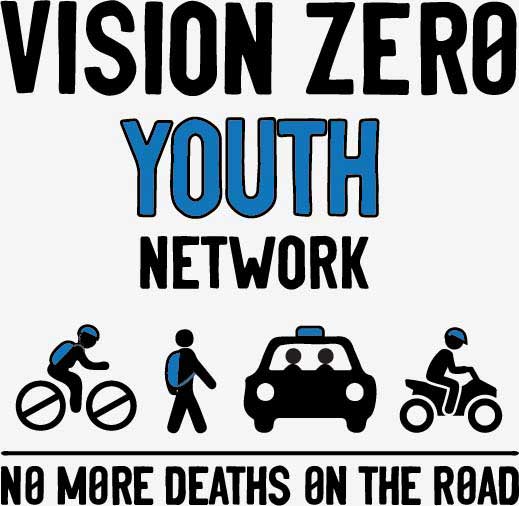
Teens in Ontario can now apply for new Vision Zero Youth Network Program.
The Vision Zero Youth Network (VZYN) by Teens Learn to Drive Inc. allows teens in Ontario ages 15-19 to gain experience and help make their communities safe.
ONTARIO, CANADA – Non-profit organization, Teens Learn to Drive Inc. (TL2D) is inviting media partners for the launch of its new leadership program for Ontario high school students called the Vision Zero Youth Network (VZYN).
In Ontario’s worst case scenario, a 16-year old could:
• Pass the G1 written test after taking 10 to 12 practice tests online. (This test concentrates on sign recognition of the rules of the road, and both are largely forgotten afterwards.)
• Drive back and forth to the grocery store for a year while parents are unaware of what their child is doing on the road.
• Practise the route of a road test a few times before taking the actual assessment – (perhaps in a much less busy region than where they live).
NOTE: During this time, the parent cannot let them drive on 400-series highways.
• On their 17th birthday, pass the 17-minute road test.
• Then pile their friends into the car and head out on the 401 – North America’s busiest road – while driving at high speeds alongside other cars, trucks, motorcycles and emergency vehicles.
If that sounds far-fetched, 62% of new drivers in Ontario do not take formal driver education (2019, MTO data). Instead, they learn from friends and family members who may have bad habits or outdated information.
Vision Zero is an idea that was developed in Sweden during the late 1990s. It aims to eliminate deaths on roads by using systems and infrastructure to lessen the damage when drivers make mistakes. Sweden also strengthened their mandatory driver education system to create safer drivers at the outset, thereby reducing the volume of serious driver errors in the first place. Compared to Sweden, most Ontario drivers start with a serious education gap about winter driving, space management, blind zones, scanning skills and behaviours that affect driving.
The VZYN will help to fill in that gap of driver education by empowering young people to work with police and other partners to create and share road safety messages about topics that concern their region.
This volunteer position is free to Ontario high school students and includes numerous benefits. Selected Ambassadors will earn their 40 Community Service hours, a $500 scholarship, and an expense-paid trip to the VZYN conference in Toronto. In addition, they will also strengthen their skills, portfolios, resumes and networks.
DATE: Wednesday, May 19
Time: 1pm
Location: Via ZOOM
Hosted by: John Derringer of Q107
Harley-Davidson Hometown Rally in Milwaukee Labor Day weekend
By Wayfarer |
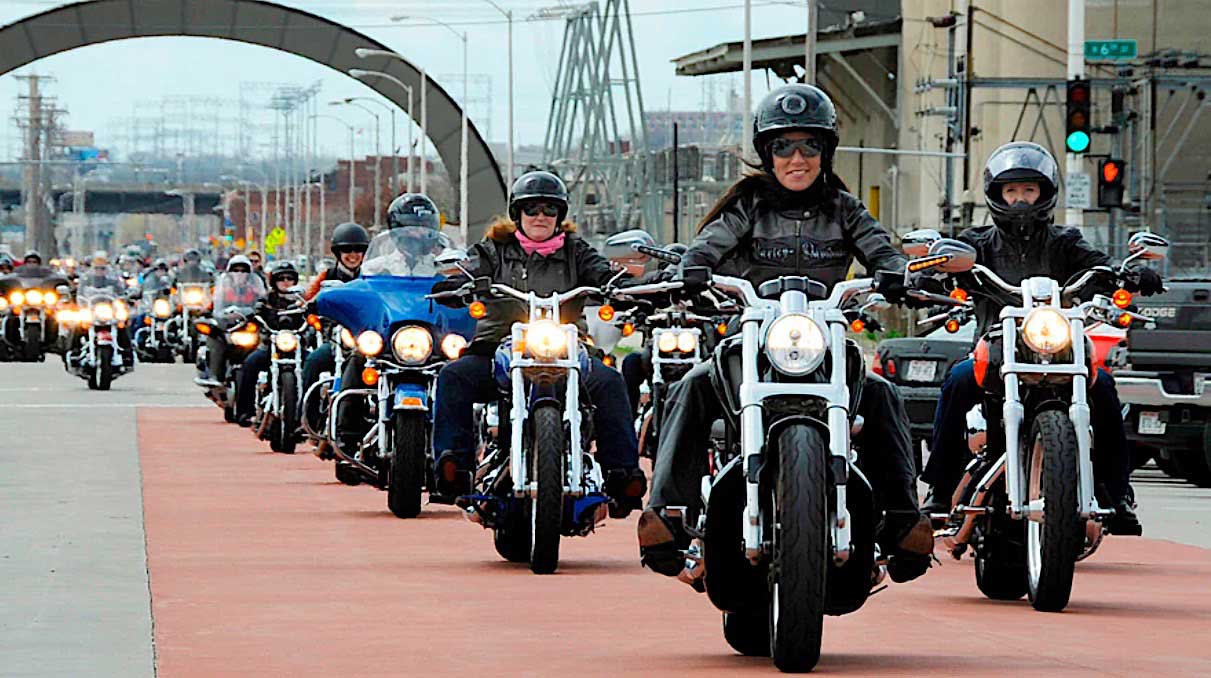
Harley-Davidson hosting a Hometown Rally in Milwaukee Labor Day weekend
by Sarah Hauer from https://www.jsonline.com/
Harley-Davidson motorcycle riders are being invited back to Milwaukee this summer for a Hometown Rally during Labor Day weekend.
Harley-Davidson, Inc. announced Wednesday it would host the Hometown Rally from Sept. 2 to 6 after stepping back from large events in Milwaukee last year because of the COVID-19 pandemic.
Harley-Davidson said the company’s museum at 400 W. Canal St., will serve as the central rally point with six nearby dealerships offering additional events.
The Harley-Davidson Museum will have free live concerts, food and beverage sites, stunt exhibitions and skills demonstrations across its 20-acre campus during the rally. The museum will also show off 2021 motorcycles. Born Free and V-Twin Visionary will host motorcycle showcases. The museum will be open for general admission.
“The Hometown Rally is an event no Harley-Davidson fan will want to miss,” said Jochen Zeitz, chairman, president and CEO of Harley-Davidson, in a news release. “It will be a celebration of all things Harley, a chance to re-connect with other riders who share the desire for adventure, freedom and community that is the real heart of the Harley-Davidson experience.”
Around 100,000 people attend the company’s Milwaukee events in anniversary years and the crowd is smaller in off years like this one — the company’s 118th anniversary.
Hometown Rally schedules will be finalized throughout the summer with updates at H-D.com/hometownrally.
Participating dealerships include House of Harley-Davidson in Greenfield, Milwaukee Harley-Davidson, Suburban Motors Harley-Davidson in Thiensville, Uke’s Harley-Davidson in Kenosha, West Bend Harley-Davidson and Wisconsin Harley-Davidson in Oconomowoc.
The Milwaukee Rally was one of the few events that weren’t canceled in 2020 because of the COVID-19 pandemic. Local dealerships took the lead in planning the annual celebration. The motorcycle company did not host any of the Milwaukee Rally events in 2020. The company said it “relies on local health guidelines to inform our participation and protect our staff, our riders and our communities” in its announcement Wednesday.
Massive Harley-Davidson Biker Bash Happening in Milwaukee on Labor Day Weekend
by Daniel Patrascu from https://www.autoevolution.com
It’s been a hell of a year in more than one respect, one that, besides turning the world upside down, robbed us of pretty much all the things we enjoyed. For better or worse, things seem to be getting back on track, and as far as plans for the future are concerned, the enthusiasm is going through the roof. This week, it’s time for Harley-Davidson fans and riders to feel the hype of a brighter future.
That’s because the Milwaukee bike maker now has announced plans for what it calls “a celebration of all things Harley” that will be taking place in its home town on Labor Day weekend, at the beginning of September. Officially titled Hometown Rally, the (hopefully) massive event hopes to get countless people together for the first time in more than a year on the Harley grounds.
The events of the Hometown Rally will be centered around the Harley-Davidson Museum and will include six surrounding Harley-Davidson dealerships. The main attraction should be the “party of the summer,” filled with live concerts on three consecutive nights, food-and-beverage sites, stunt exhibitions, and skills demonstrations.
Harley motorcycle demos, free admission to the museum, and events and merchandise dedicated to HOG members will also be on site.
On the dealerships’ lots, those taking part will also be treated to other events and entertainment. The businesses included in the event are House of Harley-Davidson (Greenfield), Milwaukee Harley-Davidson (Milwaukee), Suburban Motors Harley-Davidson (Thiensville), Uke’s Harley-Davidson (Kenosha), West Bend Harley-Davidson (West Bend), and Wisconsin Harley-Davidson (Oconomowoc).
The full details and schedules for the Rally have not yet been finalized, but the bike maker says it should have all figured out by the end of the summer. Until then, a special webpage was created where more details will be posted over the following months.
‘Hands-on’ motorcycle exhibit opens this weekend at Discovery Center
By Wayfarer |
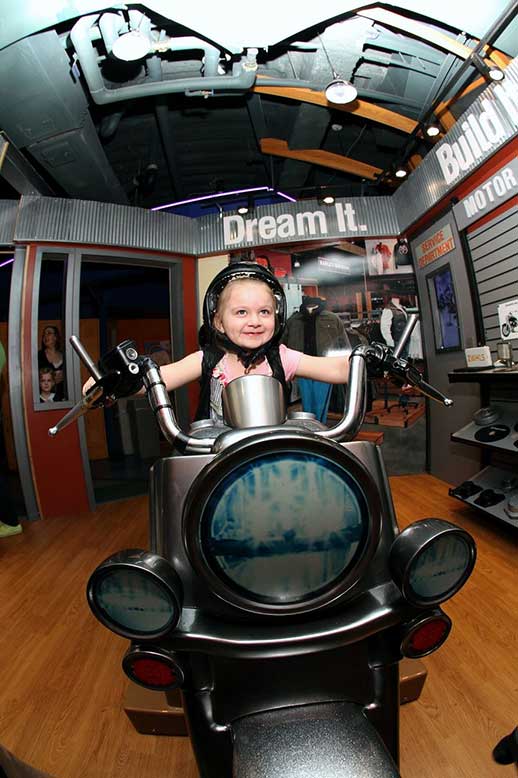
by Brandon Peoples from https://1350kman.com
KANSAS – A new traveling exhibit opens this weekend at the Flint Hills Discovery Center aimed at motorcycle enthusiasts.
Hands-On Harley-Davidson includes a kid-sized Harley-Davidson dealership with two customizable Road-King inspired motorcycles. Event Coordinator Jonathan Mertz says it’s geared toward children through three sections — Dream it, Build It and Ride It.
For the bigger kids, the exhibit includes real vintage motorcycles including a commemorative Evel Knievel Harley, a 1913 Board Track motorcycle and an XR-750 Harley.
The exhibit opens Saturday and is on display through Sept. 12 in the Tallgrass Gallery on the second floor of the Flint Hills Discovery Center.
Members of the Flint Hills Discovery Center will have an opportunity to get a sneak peek of the exhibit from 5:30 to 7:30 p.m. Friday.
Norton Motorcycles Head Of Design Takes Aim At Ducati
By Wayfarer |
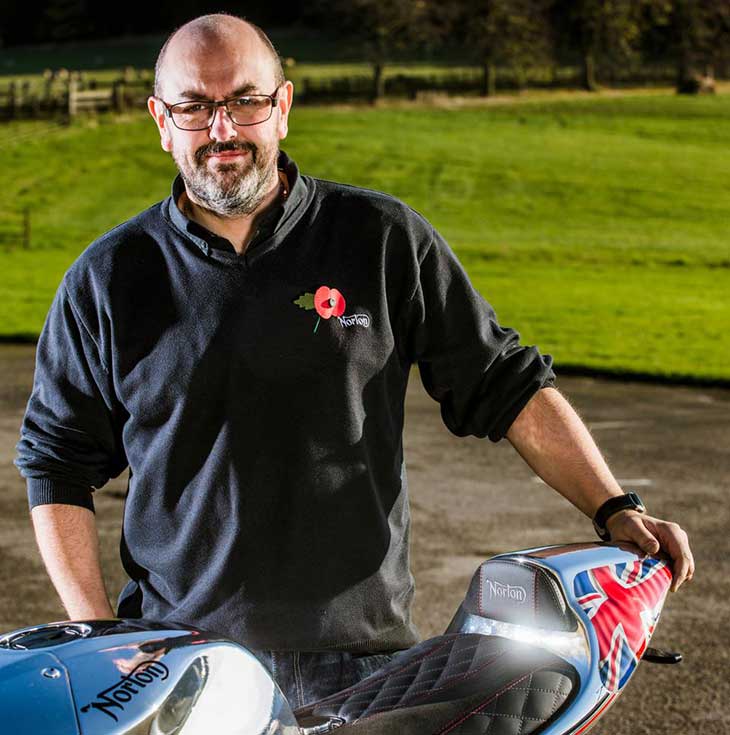
by Bryan Campbell from https://www.forbes.com
Norton Motorcycles Head of Design Simon Skinner thinks the British brand has what it takes to go head-to-head with Ducati.
Admittedly, Norton taking aim at Ducati is a very, very bold aspiration. Considering the Norton name is just as synonymous with bankruptcy and financial turbulence as it is with beautiful motorcycles, you’d be forgiven for taking the current brand revival with a handful of salt. I spoke with a refreshingly candid Norton Motorcycles Head of Design Simon Skinner via video call, who said this time will be different. While there is an incredible amount of bias in that claim, this time around there’s evidence elsewhere to back it up.
Back in January 2020, Norton entered the UK equivalent of Chapter 11 bankruptcy. The following April, the British brand was purchased by the third-largest Indian motorcycle manufacturer, TVS Motors. Now Norton has a new temporary factory in Birmingham, UK, is on a hiring spree and as Skinner puts it, ”the shackles have come off, in terms of design and innovation.” If this sounds at all familiar, there are similar plotlines going on at Jaguar Land Rover with Tata and Volvo and Lotus via Geely. Success isn’t guaranteed, but having a potent resource like TVS certainly helps.
Speaking with Skinner, I wanted to hear just how Norton plans to not just take on Ducati and become its British equal.
Bryan Campbell: Is Norton looking to follow Ducati’s lead on creating an accessible entry point with a Scrambler-esque model paired with top-tier sportbikes?
Simon Skinner: Absolutely. We’ve already designed the 650cc parallel-twin range of motorcycles — the Atlas Nomad and the Ranger — and they are comparable to the Ducati Scrambler. Ours is probably a bit more modern, a bit more capable in terms of the geometry and weight of the bike. We have a slightly smaller engine with the 650cc compared to the 800cc of the Ducati, but it’s got the same power.
The bikes in the “lifestyle” class tend to be more lifestyle-ly than capable. Where the Ducatis are a little bit of both, with the Desert Sled leaning to the more capable end of the spectrum. The Norton Ranger is very similar to the Desert Sled in that way.
Campbell: Traditionally, Norton has been a small volume manufacturer. Is the focus of the new facility meant to buck that trend?
Skinner: Yes. I’m not allowed to get into the numbers, but TVS has already invested large sums in the business and the new facility in Birmingham, in the UK, is a temporary facility. It’s 75,000 square feet, but it’s still only temporary for 3-5 years while we find a more permanent home in the local area. TVS very much have volume aspirations not far off from the production numbers of Ducati. However, the current temporary facility can handle up to 7,000 bikes per year.
Campbell: In the past year, especially in the United States, ADV motorcycles and dual sports have taken off and part of that is due to what those bikes can offer at their price points. The bang-for-buck value is undeniable. If Norton is looking to capitalize on that rising tide, where will the brand’s bar for entry be?
Skinner: An Atlas Nomad is just under £10,000 and that’s our entry-level model. If we come down from that, only time will tell, but it’s usually depending on the volume we can achieve. Our volume will never be at the level of say, Honda, but to get the combination of luxury and volume we’re chasing, it’ll be somewhere near Ducati pricing. And I can’t see us dropping below that, at least not while we’re building the brand back up.
Campbell: Stepping away from the cold hard numbers for a bit. In terms of design, where is Norton pulling inspiration from?
Skinner: Norton, traditionally, is an innovative, cutting edge, modern company. Some people think Norton a classic company, but it’s not at all. The Norton Commando, when it was launched in 1968, was the fastest superbike in the world and the Manx chassis bikes dominated race tracks year after year. That’s all down to the technology and innovation that was used. That’s where Norton needs to be again.
So, from a design perspective, I’ve employed a diverse group of designers and created an environment where they can thrive. We take our inspiration from all over but we do look at the past — the design cues, the styling cues, the ethos behind the brand — where Norton’s tend to be low, sleek, have a strong character line down the bike and are really evocative.
But on the other hand, we need to be a modern company similar to the way Ducati is a modern company. They’ve accomplished so much in history, but that doesn’t mean they make every bike look like a 916. We need to go beyond that. To go back to the glory days of Norton, we need to be innovative and right at the bleeding edge of technology and design.
It’s also natural to look to the automotive industry because it’s so advanced and there are so many resources being put into it, in terms of technology and design. The big difference is a motorcycle is more of an integrated design and engineering project. A car is clad in metal and plastic and all the engineering happens underneath. Whereas on a motorcycle, it’s all on display, so there a very few components that aren’t both functional and aesthetic.
My goal is to create an environment and process within Norton that combines engineering and design. Now we have the resource in TVS and we can take that design and engineering ethos and give it some power. The shackles have come off.
Campbell: The comparisons and competition to Triumph will be inescapable. In terms of product focus, will Norton focus on vintage-styled bikes as well as modern sportbikes, similar to Triumph’s current strategy?
Skinner: For us, it will be the other way around. We are going to do modern bikes. That’s a given. The question is, are we going to classic bikes? If we remain completely true to the Norton ethos of innovation and modernity, then we don’t do classic bikes. But let’s be honest, there’s such a huge market for motorbikes like the Triumph Bonneville and it would be crazy to ignore it.
With that said, if we most certainly will be in the modern design space. If we do a sports tourer, an ADV, or a sportbike, they will all be modern bikes.
Campbell: Drawing comparisons from the automotive industry, it sounds like Norton is in the same position Volvo and Lotus were when Geely came in and provided funding and resources. Is that a fair assessment?
Skinner: It is. Obviously, we’ve got a new owner and new shareholders to answer to and everything we need to do needs to be commercially viable. But, at the same time, TVS recognizes we have some real talent within the Norton team who have never had the opportunity to be let loose. Also similar to when Tata took on Jaguar Land Rover, it allows us the freedom to operate and gives us knowledge and personnel, so the resources go beyond just putting money in the bank.
Campbell: You could argue financial distress is almost as synonymous with the Norton name as is beautiful, fast motorcycles. Having TVS as a resource is one way to help mitigate history repeating itself, but how does Norton plan to shake that reputation?
Skinner: It’s true Norton has been through the mill, so to speak and interestingly, as a brand, it has always come out the other side with a good reputation. Regardless of who’s owned Norton, they’ve always understood what the brand means and I think that’s the strength of the brand.
Norton has been up and down financially over the years and this is the most recent chapter. TVS see themselves as the guardian and custodian of the brand, not the owners and that’s a welcomed relief. They could have taken a meaningless 200cc motorcycle, slapped a Norton badge on it, and charged a few more dollars. What they actually want to do is give Norton structure and stability and have the mindset that they need to look after it for future generations.
The quality will filter down into the product because TVS won’t compromise their beliefs for Norton. They want to build a motorcycle that leads the world in innovation, technology, design and quality. It won’t happen overnight, but that’s the vision. It’s a challenge, for sure, but TVS have that desire and drive.
Campbell: What’s the production timeline look like with those goals in mind?
Skinner: We have about 18 months before the new product starts to filter through. But we need a bit of time to fully adopt the new engineering quality, procedures and processes. When we launch in May and start production, those bikes will be the highest quality Nortons ever built in over a decade, if not ever. We’re taking it step by step and it’s going to take a period of time to have the processes in place, the structure and get the right people on the team.
When we went into administration, we had 55 employees. We now have 125 and we’re still hiring and that’s without selling any motorcycles yet. That’s a statement of TVS’s intent and investment: they want to put the people in place to make this the best brand in the world and make the best motorcycles in the world.
14th Annual Norm Dober Memorial Run
By Wayfarer |
Join us for the 14th Annual Norm Dober Memorial Run on Saturday June 19th.
Bikers Inside the Beltway – Making it Happen!!
By Wayfarer |
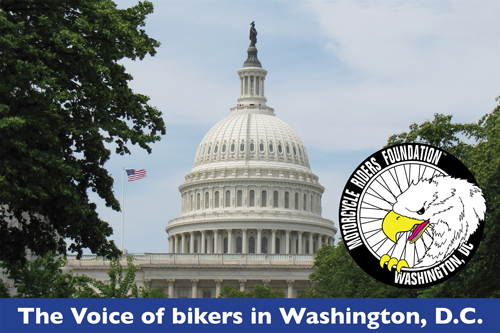
With false starts, uncertainties and a host of doubters put aside by a legion of freedom fighters, the Motorcycle Riders Foundation is once again bringing our legislative endeavors to Washington, D.C., and Capitol Hill. Bikers Inside the Beltway — Making it Happen!!
As Willie Nelson sung… “It’s been rough and rocky travelin’ but I’m finally standin’ upright on the ground…” The MRF has never stood any way but upright in the advocacy for motorcyclists’ rights. Thanks to you, the MRF is making Bikers Inside the Beltway happen! Thank you for your contribution to making our voices heard.
FYI and add the following to your travel itinerary to make things smoother when you get to the hotel: 703-684-5900 — Embassy Suites by Hilton Alexandria, 1900 Diagonal Road, Alexandria, Virginia 22314
- Briefing Session: Monday, May 17, 5:00 – 8:00 p.m., Mason Room.
- Briefing packets & handout material for your members of Congress will be available before the briefing session.
- Special appearance: Congressman Troy Balderson from Ohio is scheduled for a short appearance from 4:45 -5:45 p.m. for a Q&A with attendees.
- Zoom meeting locations: To be announced at the briefing session.
- De-Briefing Session – a recap of the day’s successes: Tuesday, May 18, 5:00 – 8:00 p.m., snacks and cash bar available, Mason Room.
“… After takin’ several readings I’m surprised to find my mind’s still fairly sound…” The briefing session on Monday evening will reinforce what you’ve always known about the nation’s premier bikers’ rights organization – the MRF is sound, strong, and focused. The de-briefing session will demonstrate just how well we are taking our message to members of Congress.
Thank you for your attendance. Thank you for your support. And thank you for helping the Motorcycle Riders Foundation protect the rights of all motorcyclists!
Yours in Freedom,
Fredric Harrell
Director, Conferences & Events
Motorcycle Riders Foundation


